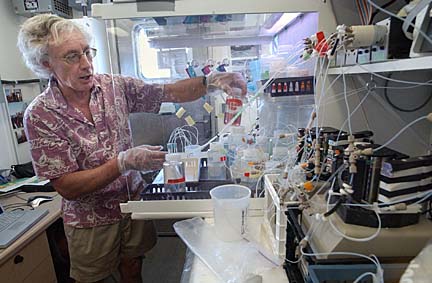
Oceanographer Chris Measures is shown here in his portable lab van secured to the deck of the research ship RV Melville, which arrived Sunday at the UH Marine Center at Sand Island.
Climate study
looks to seaResearchers at UH explore how
oceans can influence climate
University of Hawaii oceanographers Chris Measures and Eric Firing are helping to map how the world's oceans affect climate.
The researchers are trying to put together a picture of the ocean as an integrated system involving physics, biology and chemistry, Measures said.
"Until you understand that, you can't hope to predict how the Earth's climate system, which is affected by the ocean enormously, is going to react to changes caused by human activity," he said.
"Hopefully, what we'll be able to do in the next few years is paint a picture for the whole global ocean and go back and do it again in 10 to 20 years to see if things changed."
The UH researchers are conducting experiments in a trans-Pacific Climate Variability Cruise, the third in a 13-year international program that began last summer.
The program is expected to help answer such puzzles as whether an El Nino will occur next year, whether climate could suddenly switch, whether more extreme weather events will occur and how much the sea level will rise.
Measures is collaborating with Florida State University scientists to map distribution of iron and aluminum in the ocean. Both minerals affect growth of phytoplankton.
Firing and colleagues from Columbia University's Lamont-Doherty Earth Observatory are using acoustic Doppler profilers to study currents.
Measures and one of his graduate students, Lauren Kaupp, were on the RV Melville, operated by the Scripps Institution of Oceanography, which arrived Sunday at the UH Marine Center at Sand Island from Yokohama. It was scheduled to leave today for San Diego.
Firing isn't making the trip from Japan to San Diego, but his instruments are on the ship with his co-chief scientist, Andreas Thurnherr of Columbia.
Measures stayed behind to start fall classes, but two people from his lab are on the second leg of the cruise with his Florida State co-investigator, Bill Landing.
In one of the climate program's major investigations, Scripps scientists are measuring the amount of carbon dioxide going into the ocean from human activity and whether it's increasing the ocean's acidity levels.
Measures said the researchers are mapping distribution of chlorofluorocarbons, chemical compounds made by humans for industrial and house- hold use.
They appear in shallow water and can be used as a tracer to show how rapidly pollutants can be carried by water motion, he said.
Firing is using two remote-measuring devices. One is mounted to the hull and continuously covers the water at a range of about 2,310 feet below the ship.
The other instrument is mounted to a package lowered to within about 33 feet of the ocean bottom when the ship is stopped, he said. It also takes salinity, temperature and other oceanographic measurements.
In Measures' project, 12 bottles weighing 60 pounds each are lowered to about 3,300 feet to collect water samples for trace metals.
UH has a laboratory-van on the ship to analyze water samples.
The data is used to develop contour plots of the ocean for a global map of iron and dissolved aluminum, which carries iron dust, Measures said.
He displayed contour plots from the last leg showing very high iron concentrations off Japan that dropped off dramatically in the Central Pacific. The lowest amounts are where phytoplankton are blooming, he said.
High aluminum levels also were recorded in surface waters near Japan because of Asian dust, which the water carries into deeper ocean, Measures said.
